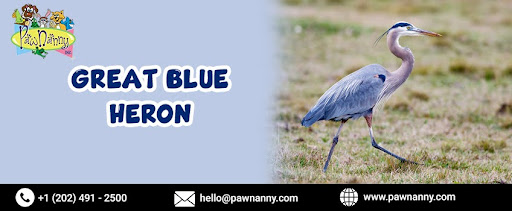
Great Blue Heron
Scientific Name: Ardea herodias
Flock Members: 2-10 members
Size: 3-4.5 feet
Weight: 4-7 pounds
Lifespan: 15-24 years
A.K.A.: Blue Heron
Behavior
The Great Blue Heron, with its majestic stature and graceful movements, exhibits a fascinating array of behaviors that contribute to its survival and success in its natural habitat. These birds are renowned for their solitary nature, often found standing motionless along the water's edge, patiently waiting for prey to approach within striking distance. One of the most striking behaviors of the Great Blue Heron is its hunting technique. With lightning-fast reflexes, they employ a sit-and-wait strategy, remaining perfectly still for extended periods until an opportunity presents itself. Once a suitable prey item, such as fish, amphibians, or small mammals, comes within range, the heron swiftly strikes with its dagger-like bill, securing its meal with remarkable precision. As pets, they need overnight stays services for pets when their parents are not around.
Great Blue Herons are also skilled fliers, capable of soaring gracefully across the sky or navigating tight spaces with agility. Their long, slender wings and slow, deliberate wingbeats contribute to their aerial prowess, allowing them to cover large distances in search of food or suitable nesting sites. During the breeding season, Great Blue Herons engage in elaborate courtship displays to attract mates. These displays may include aerial maneuvers, intricate rituals, and vocalizations designed to demonstrate fitness and establish pair bonds.
Despite their typically solitary nature, Great Blue Herons may congregate in colonies, or rookeries, during the breeding season. These communal nesting sites provide protection from predators and facilitate social interactions among individuals. Parental care is another notable behavior of Great Blue Herons. Both parents participate in incubating the eggs and feeding the young, regurgitating food into the chicks' mouths until they are old enough to forage on their own.
History
The Great Blue Heron (Ardea herodias) is a majestic and iconic bird that holds a significant place in natural history. With a range extending across much of North America, from Canada to Mexico, these wading birds are a common sight in wetlands, marshes, and along the shores of rivers, lakes, and coastal areas. The history of the Great Blue Heron stretches back thousands of years, with evidence of their existence found in fossils dating back to the Pleistocene epoch. Throughout history, these birds have been revered and depicted in various cultures and mythologies. Indigenous peoples in North America often associated them with wisdom, patience, and balance, attributing spiritual significance to their graceful presence.
European settlers encountering these birds in the New World were struck by their beauty and adaptability. In the 19th and early 20th centuries, Great Blue Herons faced threats from habitat destruction and hunting for their feathers, which were highly valued in the fashion industry. Conservation efforts, including the establishment of protected areas and regulations on hunting, helped stabilize their populations.
Today, the Great Blue Heron remains a symbol of resilience and conservation success. Their populations have rebounded, and they continue to thrive in a variety of habitats. These birds play a crucial role in the ecosystem, controlling fish populations and contributing to the balance of wetland ecosystems. As human activities increasingly impact natural habitats, the conservation of Great Blue Herons and their habitats remains a priority. Through continued research, habitat preservation, and public education, efforts are underway to ensure that future generations can continue to admire and appreciate these magnificent birds in the wild.
Breeding
Breeding behaviors of the Great Blue Heron are fascinating and integral to their survival as a species. These majestic birds are known for their elaborate courtship displays and their communal nesting habits. During the breeding season, which typically occurs in the spring, Great Blue Herons engage in intricate courtship rituals. Males perform aerial displays, including stretching their necks, puffing out their chest feathers, and flying in wide circles around potential mates. They also bring nesting materials to females to showcase their suitability as partners. Once a pair forms a bond, they engage in mutual preening and other bonding behaviors.
Nesting colonies, known as rookeries or heronries, are essential for Great Blue Herons' breeding success. These colonies can consist of dozens to hundreds of nests, built high in trees or on rocky cliffs near bodies of water. Both parents participate in nest-building, constructing large platforms of sticks and twigs lined with softer materials such as grasses and moss. Once the nest is built, the female typically lays three to six pale blue eggs, which both parents take turns incubating for about four weeks. After hatching, the chicks are altricial, meaning they are born helpless and rely entirely on their parents for food and protection. Both parents diligently feed the chicks regurgitated food, usually small fish and invertebrates caught in nearby waters.
The breeding season is a critical time for Great Blue Herons, as successful reproduction ensures the continuation of their species. However, breeding colonies face threats such as habitat loss, disturbance from human activities, and predation. Conservation efforts focus on protecting nesting sites and minimizing disturbances to ensure the continued breeding success of these magnificent birds.
Food and Nutrition
The Great Blue Heron (Ardea herodias) is a majestic and solitary bird known for its striking appearance and graceful movements. While their primary habitat is wetlands, they can also be found near rivers, lakes, and coastal areas, where they hunt for fish, amphibians, reptiles, and small mammals. Their diet is diverse and adaptable, allowing them to thrive in various environments. Food plays a crucial role in the life of the Great Blue Heron, providing the necessary nutrients for survival and reproduction and should be mindfully given during pets overnight stays services. Their staple diet consists mainly of fish, which they catch with their long, sharp bills in shallow waters or by patiently waiting along the shoreline. Additionally, they prey on a variety of aquatic creatures such as frogs, crayfish, and small rodents, supplementing their diet with insects and occasionally even small birds.
Nutritionally, the Great Blue Herons diet is rich in proteins, essential fats, vitamins, and minerals, ensuring their overall health and vitality. The high-protein content of fish contributes to their muscle development and energy levels, enabling them to soar effortlessly through the sky and hunt with precision. The nutritional needs of Great Blue Herons vary throughout their life cycle, with breeding adults requiring additional nutrients to support egg production and chick rearing. During the breeding season, they may consume larger quantities of food to meet the demands of their growing offspring.
Conclusion
The Great Blue Heron, scientifically known as Ardea herodias, is a majestic bird found across much of North America. In the wild, these herons inhabit a variety of wetland habitats, including marshes, swamps, rivers, and lakeshores. They are skilled hunters, using their long necks and sharp bills to catch fish, frogs, insects, and other small prey. Their striking blue-gray plumage, dagger-like beak, and impressive wingspan make them a captivating sight for birdwatchers and nature enthusiasts alike.
While Great Blue Herons are admired for their beauty and grace in the wild, they are not typically kept as pets. Their large size, specialized dietary needs, and requirement for ample space to fly and hunt make them unsuitable for captivity. Additionally, keeping wild birds as pets is often illegal and can have detrimental effects on both the individual bird and its wild populations. Therefore, it's best to appreciate these magnificent creatures in their natural habitats, where they play vital roles in maintaining healthy ecosystems. For more information or to avail pets overnight stays services Fairfax, visit PawNanny.com .










